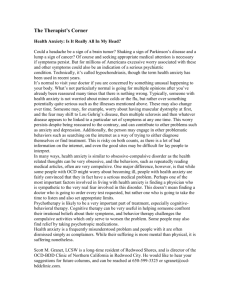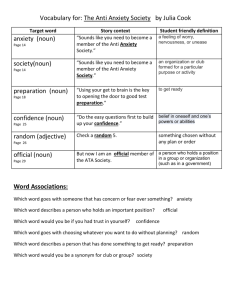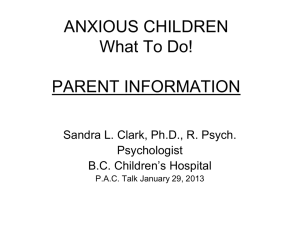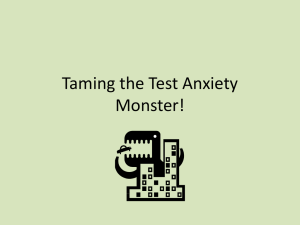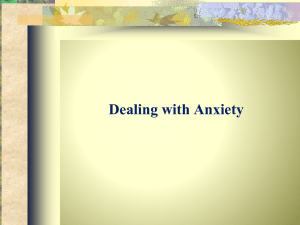How to Help Your Overanxious Child
advertisement
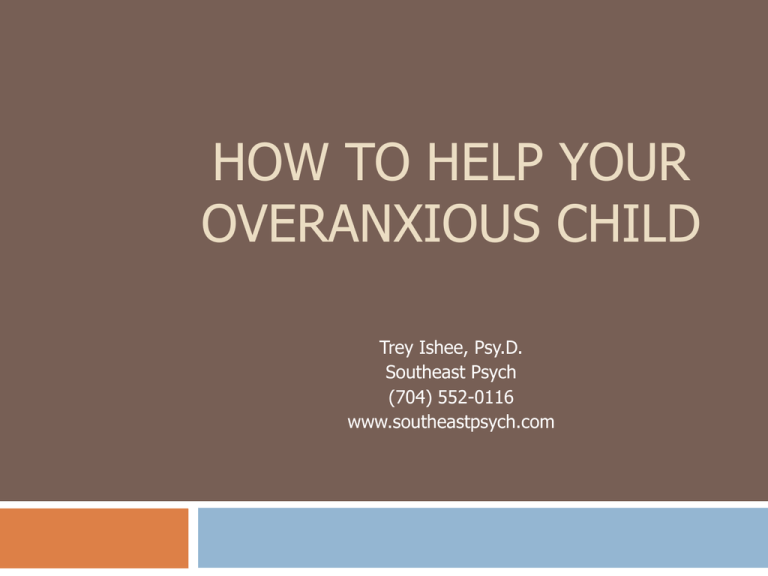
HOW TO HELP YOUR OVERANXIOUS CHILD Trey Ishee, Psy.D. Southeast Psych (704) 552-0116 www.southeastpsych.com WHAT IS ANXIETY? All of us experience anxiety at some time Normal developmental pattern that is exhibited differently as children grow older Anxiety can arise from real or imagined circumstances One common definition is apprehension or excessive fear about real or imagined circumstances Triggers can be external and/or internal SIGNS OF ANXIETY Cognitive Behavioral Concentration difficulties Catastrophizing events Worrying Perfectionism Memory problems Overreactions Hyper vigilant Lack of confidence Shyness Withdrawal Frequent questions Frequent need for reassurance Need for sameness Excessive talking Restlessness Habit behaviors (biting nails, twirling hair) Impulsiveness Physical Trembling/shaking Increased heart rate Shortness of breath Dizziness Flushing of skin Stomachaches or nausea Muscle tension Sleep problems 3 TIMES THAT CHILDREN WORRY Anticipation Experiencing the Feared Event Rumination HOW IS ANXIETY MAINTAINED? Self-talk or “automatic thoughts” Avoidant behavior Inappropriate response to a fearful child HOW DO YOU HELP YOUR CHILD? Maintain a consistent (but flexible) routine for homework, chores, and activities Help children express their feelings Don’t deny your child’s worries, ask “why”, or reassure them excessively Answer questions honestly Maintain realistic, attainable goals and expectations for your child and yourself Accept mistakes as a normal part of growing up Distinguish between perfection and excellence Distinguish between “wants” and “shoulds” HOW DO YOU HELP YOUR CHILD? Focus on the attention the child receivespraise their effort and their courage Remind your child of previous successes Be a good role model for your child (and talk out loud) Develop a reinforcement system if needed (with graded steps towards a goal) Encourage independent activities and selfreliance Compromise Schedule activities in moderation HOW DO YOU HELP YOUR CHILD? Help your child visualize-”Paint the Picture” Plan for transitions Teach your child strategies to help them handle anxiety: Develop scripts of what to do or say in feared situations and teach calming self-talk (change their “automatic thoughts”) Teach your child how to relax Help them problem-solve Help them plan instead of worry (i.e. practice for a specific event to build confidence) Organize their materials and time to reduce stress Provide alternate activities to distract your child from worries Allow “worry time”, have a “worry doll” or a “worry box” Use “coping cards” HELP AT SCHOOL Prepare for transitions (substitutes, fire drills, field trips) Class participation Assignment modifications Extended time for tests “Cool down” pass or safe place Preferential seating HELPFUL RESOURCES What To Do When You Worry Too Much (A Kid’s Guide to Overcoming Anxiety) (Huebner, D. 2006) The Worried Child: Recognizing Anxiety in Children and Helping Them Heal (Foxman, P. 2004) Your Anxious Child: How Parents and Teachers Can Relieve Anxiety in Children (Dacey, J.S. & Fiore, B. 2001) Keys to Parenting Your Anxious Child (Manassis, K. 1996) Freeing Your Child From Anxiety: Powerful, Practical Solutions to Overcome Your Child's Fears, Worries, and Phobias (Chansky, T. 2004) Wemberly Worried (Henkes 2000) When My Worries Get Too Big! A Relaxation Book for Children Who Live with Anxiety (Buron, K. 2006) www.aada.org (Anxiety Disorders Associate of America) www.childanxiety.net (The Child Anxiety Network) www.childhoodanxietynetwork.org www.schoolbehavior.com www.nasponline.org www.worrywisekids.org

